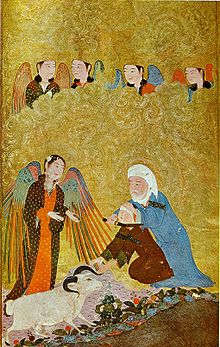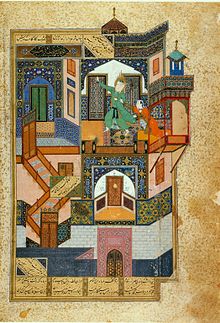Timurid art

Timurid art is a style of art originating during the rule of the
Considered a rich period of Persian artistic revival, Timurid art can be characterized by an emphasis on book arts and
History
The Timurid Empire was established by
Architecture

The Timurids utilized architecture for political and social means, for example to create a sense of national identity through a uniform aesthetic. Other reasons for architectural patronage include commemorating reigns of rulers and creating spaces for religious purposes and social benefits.[6] Important examples of Timurid architecture mainly preside in Samarkand, Mashhad, Khargird, Tayābid, Baku, and Tabrīz. The most common existing examples of Timurid architecture include congregational mosques, private mosques, mausoleums, madrasas, khanqahs and caravansaries, and Sufi shrines.[7][1] During the Timurid period, women were especially active patrons of architecture.
The first major work of architectural patronage commissioned by Timur in 1389 was the
Distinct features of Timurid architecture include: courtly gardens with hard and soft architecture, large double domes, vaulting systems,
Illustration

Persian manuscript paintings usually are recognized regarding their embellished purpose. The paintings serve as a visual interpretation of the paired passages, customarily indicating royal authority and traditions. Timurid paintings also served as a medium for artistic performance and self-representation, Painters were considered the most skilled in their trade, and were highly regarded.[9] The illustrations often represented what was happening in the text. These pictorials were composed of faithful stories and lessons through vibrant worlds and displays that highlighted themes such as education, government, speech, and religious practice.[10][11]
Timurid art absorbed and improved upon the traditional Persian concept of the "Arts of the Book". The new, Timurid-inflected works of art saw illustrated paper (as opposed to parchment) manuscripts produced by the empire's artists. These illustrations were notable for their rich colors and elaborate designs.[12] Due to the quality of the miniature paintings found in these manuscripts, Suzan Yalman of the Metropolitan Museum of Art noted that "the Herat school [of manuscript painting] is often regarded as the apogee of Persian painting."[1]
These painting were not limited to manuscripts, as many Timurid artists also created intricate wall paintings. Many of these wall paintings depicted landscapes derived from both Persian and Chinese artistic traditions.[13] While the subject matter of these paintings was borrowed from other cultures, Timurid wall paintings were eventually refined into their own, unique style.[14] Mongol artistic traditions were not entirely phased out, as the highly stylized depictions of human figures seen in 15th-century Timurid art are derived from this culture.[15]
Manuscripts

Under the rule of the Timurid Empire, the production of illuminated manuscripts flourished. Characterized by rich colors and elaborate designs, these manuscripts served as essential documents of Timurid material culture and reflected the craftsmanship of differing conquered territories.[16] The Timurid art period is defined by artists and calligraphers such as Kamāl ud-Dīn Behzād, Sultan 'Ali al-Mashhadi, Umar Aqta, Ja'far Baisunghuri and many others. Often the manuscripts were worked on by multiple artists over time, creating a combination of different art styles into each manuscript.
The majority of manuscripts were made in royally-sponsored workshops or kitabkhanas.[6] The Timurids remained true to their heritage by continuing earlier traditions associated with the Ilkhanid Mongols and Jalayirids. This includes the refinement of the six canonical cursive scripts under the Ilkhanid Mongols. They distinguished themselves by developing another cursive script in the late 1300s, nasta'liq.
The height of manuscript manufacturing under the Timurids was under the

The Cairo Bustan
The Cairo Bustan is one of many influential manuscripts recorded in Persian book arts. The Cairo Bustan is among the few surviving illustrated manuscripts that hold records connected to Sultan Husayn Bayqara’s patronage. The manuscript describes and displays its historical content with noble precision, and contains many original paintings of Kamāl ud-Dīn Behzād. Behzād had produced the first complete record of this manuscript as well as its illustrations.[10] He was revered among Persian painters, and defined the height of Islamic manuscript paintings.
Anthology of Persian Poetry
The Anthology of Persian Poetry is an illuminated manuscript that was copied down during the reign of Iskandar Sultan in 1411. Iskandar Sultan was a patron of the arts, and he was descended from Timur. After the first additions to the manuscript, some pages intended for illustration were left blank. Later these pages would be illustrated by Turkman Aq Quyunlu and other Ottoman creative minds.[17] By observing the style of each addition to the manuscript, historians can tell where the manuscript traveled during its creation. The nasta'liq writing in the manuscript was likely done by Mir ‘Ali Tabrizi, who was a well-known calligrapher of Shiraz manuscripts from 1405 to 1429.[18]
Metalwork
Although lesser in number than manuscripts, the Timurid Empire also produced quality pieces of metalwork following Timur's invasion of Iran.[19] Steel, iron, brass, and bronze were commonly used as mediums.[19] Timurid silver-inlaid steel is often being cited as being of particularly high quality.[20] Additionally, gold and silver vessels required skilled craftsmanship.[3]
In the Islamic period, Herāt was also a center for metalworking.[3] Many of the techniques and designed utilized had their origins in the Sasanian era. The earliest metalwork produced under the Timurids includes a bronze basin and six brass oil lamps, preserved at the Mausoleum of Khoja Ahmed Yasawi.[7] Inscriptions indicate that the basin was made specifically for this context.
Following the collapse of the Timurid Empire, several Iranian and Mesopotamian cultures co-opted Timurid metalwork.[19] Many objects made of precious metals were likely melted down to be repurposed.[3]
Ceramics and Carving

Chinese-style ceramics were produced by Timurid artisans. During the Timurid period, mosaics were especially favored, with colored tiles fired and then cut into interlocking shapes.[3] This eventually was overcome by the cuerda seca technique. Different colors can be put onto a tile and then the colored areas are outlined by a greasy substance and the tile is fired. This technique came about as early as the late fourteenth century and was especially popular later on in Safavid Iran.
Jade carving also had a presence in Timurid art, also likely inspired by Chinese art. The Timurids effectively introduced jade carving to the Islamic lands.[3]
Legacy
Following the decline of the Timurid Empire in the late 15th century, the Ottomans, Safavid dynasty, and Mughal Empire co-opted Timurid artistic traditions into their own.[2][1] The art and architecture produced by the Timurids presents a unique national identity and has served as an inspiration all over the Islamic world, from Anatolia to India.[1]
Gallery
-
A Timurid carved jade sword hilt.
-
Timurid-inspired image of Babur.
-
15th century Timurid tankard made in Herat.
-
A fragment of Timurid Architecture made ca. 1375-1400, ceramic, stone paste; painted underglaze.
-
A page from Anthology of Persian Poetry 15th Century, made of ink, gold leaf, opaque watercolor, silver leaf, book bound by leather.
-
A page from the Qur’an of Ibrahim Sultan, made by Ibrahim Sultan, ca. 1427, watercolor, ink, gold leaf on paper.
-
A page from "The Eavesdropper", Folio 47r from a Haft Paikar (Seven Portraits) of the Khamsa (Quintet) of Nizami, Calligrapher: Maulana Azhar, Poet: Nizami Ganjavi, ca. 1430, watercolor, ink, gold leaf on paper.
-
A painting called "Wine Drinking in a Spring Garden", ca. 1430, gold and opaque watercolor on undyed silk.
-
A page from "Laila and Majnun at School", Folio from a Khamsa (Quintet) of Nizami, Calligrapher: Ja'far Baisunghuri, Author: Nizami Ganjavi; 1431-1432, watercolor, ink, gold leaf on paper. Commissioned by Sultan Baysongor Khan.[21]
-
Tile from a Squinch, late 14th century, stone paste carved and glazed.
-
A bowl, late 15th century, black paint under turquoise glaze, incised.
-
Section of a Qur'an Manuscript, Calligrapher: Copied by `Umar Aqta', late 14th century, watercolor, ink, gold leaf on paper.
-
A folio from "Funeral Procession", Folio 35r from a Mantiq al-tair (Language of the Birds), Calligrapher: Sultan 'Ali al-Mashhadi, Author: Farid al-Din `Attar; 1487, watercolor, ink, gold and silver leaf on paper.
-
Carved Door Panellate 15th century, made in present-day Uzbekistan, Samarqand, made of cypress, carved, painted.
-
Divan of Sultan Husayn Bayqara, dated A.H. 905/ A.D. 1500, watercolor, ink, gold leaf on paper.
References
- ^ a b c d e f g h Komaroff, Authors: Suzan Yalman, Linda. "The Art of the Timurid Period (ca. 1370–1507) | Essay | Heilbrunn Timeline of Art History | The Metropolitan Museum of Art". The Met’s Heilbrunn Timeline of Art History. Retrieved 2017-11-16.
{{cite web}}: CS1 maint: multiple names: authors list (link) - ^ a b "The Timurids and the Turkmen - The David Collection". www.davidmus.dk. Retrieved 2017-11-16.
- ^ )
- ^ "Mongol Empire: Arts and Culture". 27 July 2014.
- ^ B.F. Manz; W.M. Thackston; D.J. Roxburgh; L. Golombek; L. Komaroff; R.E. Darley-Doran (2007). "Timurids". Encyclopedia of Islam, online edition. "During the Timurid period, three languages, Persian, Turkish, and Arabic were in use. The major language of the period was Persian, the native language of the Tajik (Persian) component of society and the language of learning acquired by all literate and/or urban Turks. Persian served as the language of administration, history, belles lettres, and poetry."
- ^ )
- ^ a b Foundation, Encyclopaedia Iranica. "Welcome to Encyclopaedia Iranica". iranicaonline.org. Retrieved 2022-12-07.
- ISBN 978-90-474-2844-2.
- ^ Timur and the princely vision: Persian art and culture in the fifteenth century. 1989-12-01.
- ^ a b Balafrej, Lamia (2019). The Making of the Artist in Late Timurid Painting. Edinburgh: Edinburgh University Press. pp. 1–13.
- ISSN 1543-950X.
- ^ "Iransaga - Persian Art, The Timurids". www.artarena.force9.co.uk. Retrieved 2017-11-16.
- ^ "Timurids" The Columbia Encyclopedia (Sixth ed.). New York City: Columbia University. Retrieved 2006-11-08.
- ^ Lentz, W. Thomas. Dynastic Imagery in Early Timurid Wall Paintings. Los Angeles Museum of Art. URL:https://archnet.org/system/publications/contents/4320/original/DPC0599.pdf?1384784647
- ISBN 0300064659.
- S2CID 192618863, retrieved 2021-12-06
- . Retrieved 2021-12-06.
- S2CID 194093871.
- ^ a b c electricpulp.com. "METALWORK – Encyclopaedia Iranica". www.iranicaonline.org. Retrieved 2017-11-16.
- ^ The Caspian Sea Journal ISSN: 1578-7899 Volume 10, Issue 1, Supplement 3 (2016) 127-132 The Compilation of One Object of Timurid Metalwork (12th Century) in the National Museum of Iran with Two Objects in National Museum of Yerevan-Armenia. URL: http://csjonline.org/CSJ/2016/Supp3/127-132.pdf
- ^ "Laila and Majnun at School", Folio from a Khamsa (Quintet) of Nizami of Ganja". metmuseum.









![A page from "Laila and Majnun at School", Folio from a Khamsa (Quintet) of Nizami, Calligrapher: Ja'far Baisunghuri, Author: Nizami Ganjavi; 1431-1432, watercolor, ink, gold leaf on paper. Commissioned by Sultan Baysongor Khan.[21]](http://upload.wikimedia.org/wikipedia/commons/thumb/1/13/%22Laila_and_Majnun_at_School%22%2C_Folio_from_a_Khamsa_%28Quintet%29_of_Nizami_MET_DP159399.jpg/90px-%22Laila_and_Majnun_at_School%22%2C_Folio_from_a_Khamsa_%28Quintet%29_of_Nizami_MET_DP159399.jpg)





